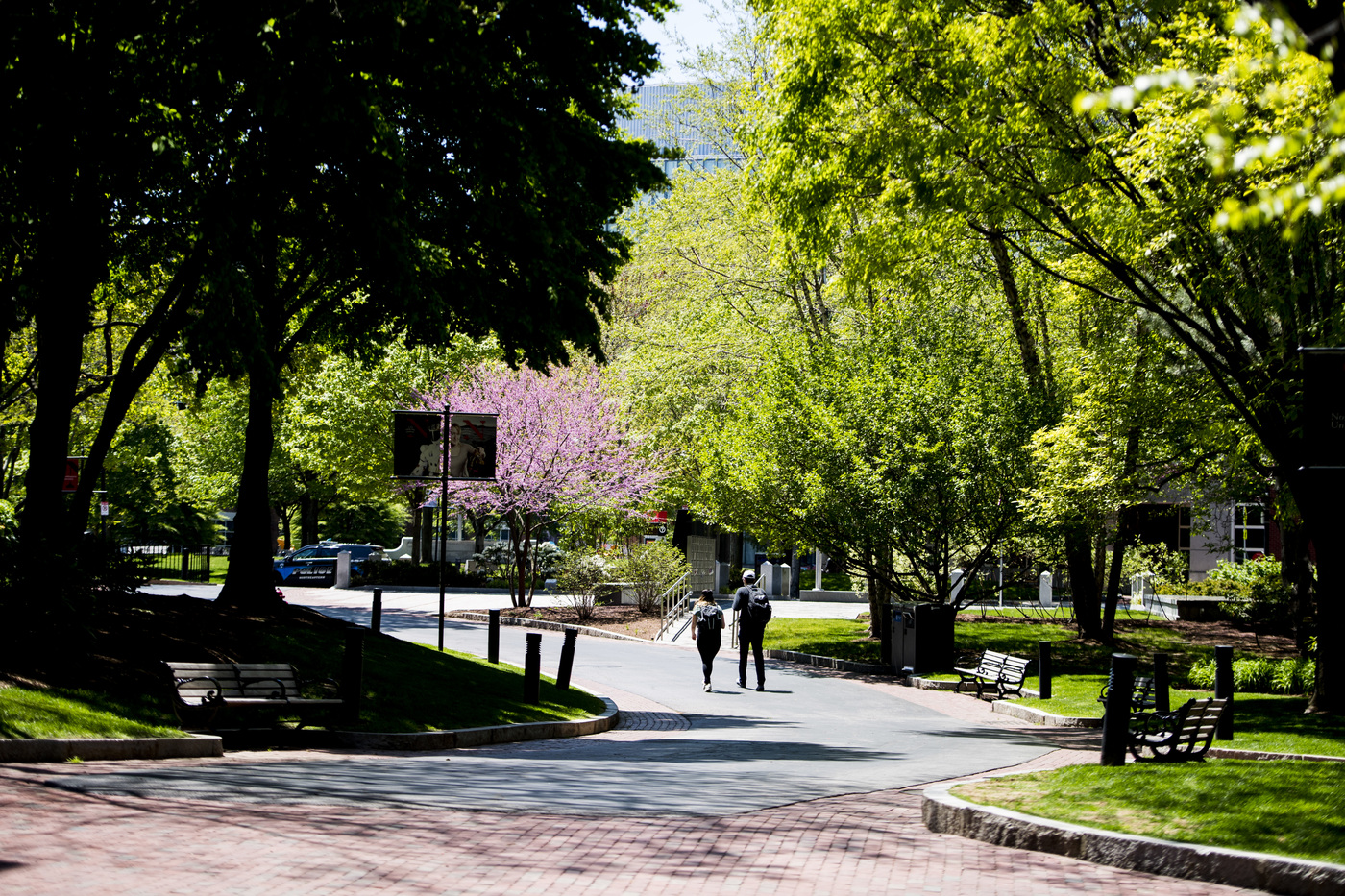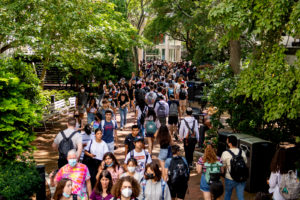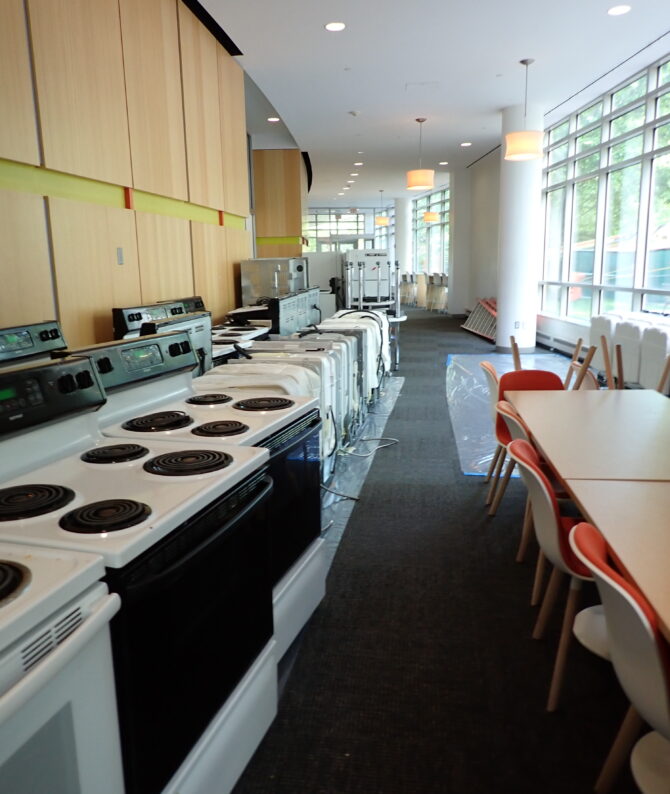Finding the Balance

If you’ve been to Northeastern’s Boston campus during the spring, summer, or fall, you’ve probably been impressed. In the spring, it’s an explosion of color, and in the summer, a lush sea of green. In the fall, vivid colors appear before falling to the ground, ready to start the cycle over the next year. One popular question that people ask about the landscaping is if it’s organic.
Typically, when a landscape or space is described as being cared for using organic methods, you’re categorizing it as a space that is exclusively being treated in an organic way with no synthetic chemicals used,” said Stephen Schneider, Northeastern’s Director of Horticulture and Grounds.
That’s not the case for the Boston campus. Instead, a hybrid approach is used, meaning the use of both organic and synthetic products – and for good reason. The world of landscaping is more than just mowing lawns and raking leaves. Overseeing the landscape of a college campus, especially one that qualifies as an arboretum, requires knowledge of horticulture, botany, and soil chemistry.
“I do believe there are opportunities for parts of our Boston campus to take advantage of a fully organic approach,” Schneider said. But in some cases, committing to being 100% organic is neither practical nor smart.
Take the example of Centennial Common. It’s one of the few large, open lawn areas on campus, and on nice days it’s packed with students trying to photosynthesize.

Photo by Matthew Modoono/Northeastern University
“A good organic program is akin to eating whole foods,” Schneider said. “The synthetic approach is more like getting nutrition through a tube and a bag.” The whole-food diet may sound like the best option, but when the lawn is constantly under stress like it is during the warmer months and finds itself in crisis mode, it’s often not a realistic solution. “When there are a couple thousand of us pounding on a lawn every day, there is no practical organic solution to keep that lawn perfect. That is when upkeep shifts from eating a healthy meal to getting hooked up to the IV.”
Schneider also makes it clear that he’s not the biggest fan of lawns in general. “If you look anywhere else in nature, you won’t often see a single plant species growing by itself. Other plants want to move in because a more diverse ecosystem is stronger; a lawn is the elimination of that diversity.
So, maybe the best course of action would be to get rid of lawns completely? Not so fast.
“I’m not a lawn person, but I’m a realist. It’s important to have green open spaces where people can gather. It’s important to have sports fields and picnic spaces. The last thing you want is for the grass to fail and the soil to erode away. That just results in a loss of quality open space.”
When caring for these lawns or any other plants, it’s usually the parts above the soil line that grab our attention, but the visible parts are not the whole story.
“Any time I have a plant or a tree that is having a problem, my first question is ‘what’s going on with the soil,’” Schneider said. “It’s not just the nutrients in the soil; there is a whole community of bacteria and fungi that are in the soil. If you’re blasting it with all kinds of chemicals, life becomes scarce and the soil becomes less of a living organism and more just a medium that the roots can grow into.”
When soil lacks health, more chemical fertilizer is needed to give the plants what they need to survive. So, overusing chemicals guarantees you need to keep using chemicals in the future, like the plant version of addiction. Not only does the overuse of chemicals destroy the soil, it also poses risks to humans and other animals.
Groundwater is a primary concern, because synthetic fertilizers and pesticides tend to leach into and contaminate it. This is an even bigger concern if you live in an area that uses well water, but even in areas that don’t use wells, groundwater contamination can still have negative effects. In Boston, groundwater ends up in the Charles River and the ocean, not exactly the places you want to be dumping chemicals.
Despite the problems with chemical applications, it’s not always simple and easy to go completely organic. Schneider started his current job in June of 2021, but he’s heard stories about some of the problems that can arise when people don’t know exactly what they’re getting into.
One of those times was when they decided to use compost that wasn’t yet matured. “My predecessor told me about when some fresh, rather ripe compost was put down in a few of the planting beds on campus,” he said with a laugh. “The trees and shrubs probably thought it was great, but then the fresh air intakes sucked in the earthy odors and completely smoked out Robinson and Mugar. That’s when the complaints started coming in. People thought the buildings were filling with sewage.”
When composting is done correctly and allowed time to mature, there shouldn’t be any bad odors. But it’s easy to get the wrong idea and equally easy to just give up completely and use chemicals.
“Although the desire is to seek ways to go organic, one has to weigh out the spectrum of organic products available to us against their practical use in a crowded, urban space, and decide which ones can successfully provide the proper amount of nutrition that our plants need to be successful,” Schneider said. “I’m a firm believer that when you can and when it’s practical, go the organic route. But make sure that you’re not wasting product when you need something more specialized. Our hope is to eventually tip the scale more and more towards the organic approach.”

Photo by Matthew Modoono/Northeastern University
Schneider will continue to work on nurturing the healthiest plants possible while minimizing negative environmental impacts from fertilizers and pesticides. But there are also issues with the equipment used to maintain the space. Gas powered landscaping equipment has long been popular because of its power and convenience. But the environmental damage it causes is substantial. Two-stroke engines are the worst offenders.
According to a 2011 study by Edmunds, a two-stroke gas-powered leaf blower emits more pollution than a Ford F-150 SVT Raptor pickup truck. Hydrocarbon emissions from half an hour of leaf blowing equal those from driving the truck from Texas to Alaska.
Schneider’s team of ten in-house crew members is transitioning toward using electric equipment, and now uses four battery powered backpack blowers. Because they’re less powerful than gas blowers, the team still uses gas ones in the fall when the massive piles of leaves are too much for electric to handle efficiently. Schneider is in the process of purchasing four-stroke blowers for this purpose, which still run on gas, but pollute less than two-stroke engines.
The school also hires help from a landscape contracting company. “My goal is to eliminate all of our two cycle engines within practicality. I’ve been focused on the backpack blower to start with,” Schneider said. “I’ve informed [the landscape contractor] that no two cycle backpack blowers are allowed on campus, period.”
Aside from leaf blowers, the team is looking at purchasing their first electric zero turn mower this year. The grounds equipment storage space has also been recently outfitted with extra electrical charging capacity so they have a place to plug everything in. “Ideally I would love to have all our lawn care equipment electric,” he said.
Although Schneider has been on the job for less than a year, he’s clearly committed to finding balance in everything he does; the balance between organic and chemical, gas and electric, and even in how he communicates the work that he’s doing.
“Finding ourselves in an academic atmosphere, I feel there’s a major opportunity to not oversimplify things in terms of all or nothing, and have intelligent conversations about phased and hybrid approaches. Additionally, as we make strides, opportunities to educate people about the complexities involved with organic gardening keep driving the conversation.”
In a time where people often gravitate to the extremes and promises that are high in flash and low in substance, Schneider is here to provide a steady diet of practical solutions.
“There needs to be compromise in anything that you do, especially when it comes to an urban landscape,” he said. “There are so many nuances that one needs to make a serious effort to look for opportunities where you can go some or all organic, while also mixing in conventional approaches so that the overall approach is successful. The last thing you want is to expend double or triple the effort to fix something that has failed.”
Written by Adam Doucette – 3/23/2022



